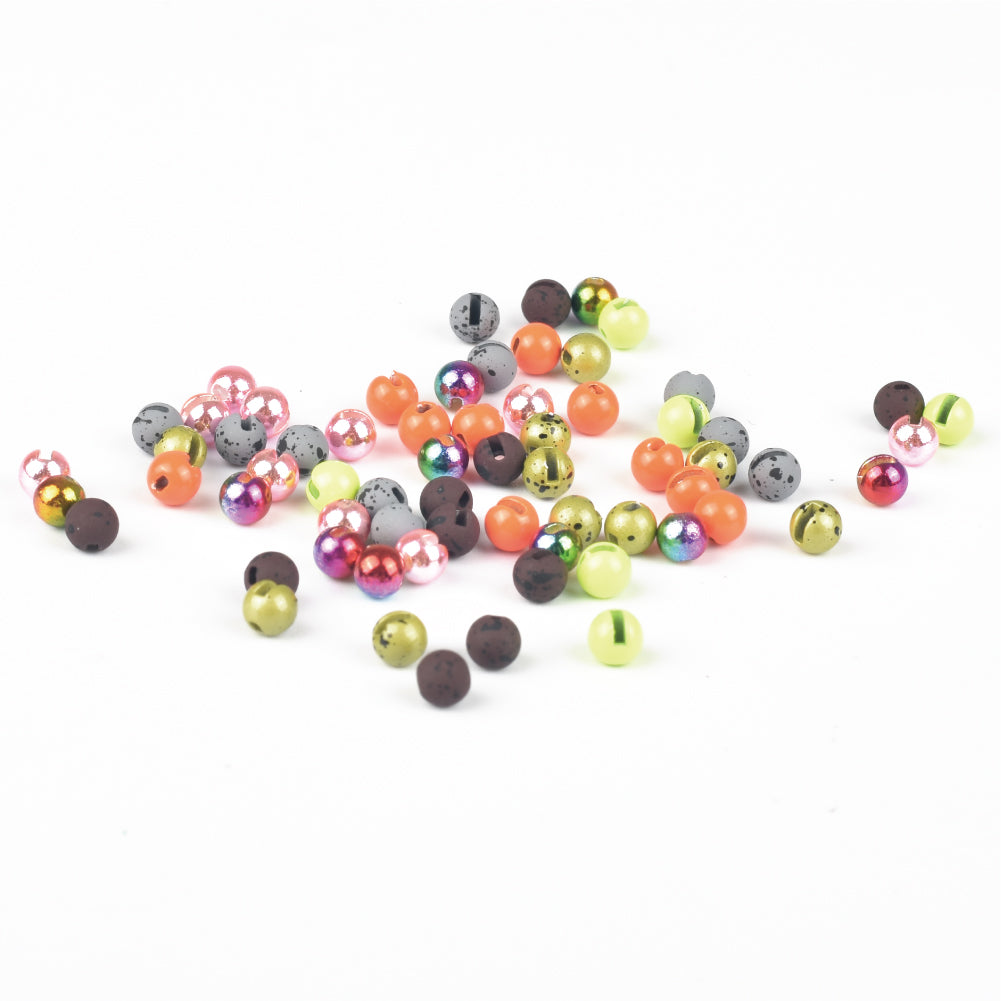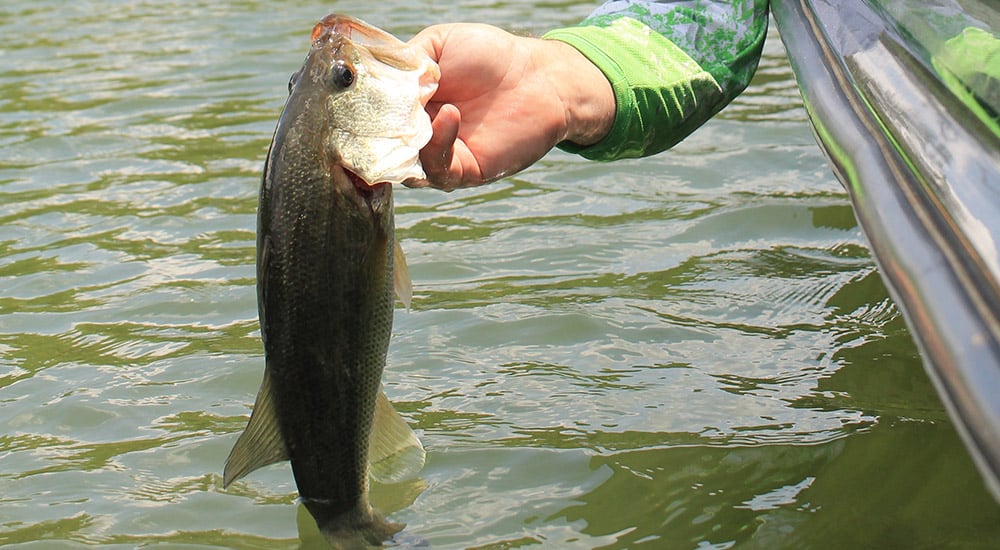We fish for one reason, and one reason only:
To catch big largemouth bass.
Try and tell me I'm wrong: There’s nothing like feeling a tug on the other end of your line, setting the hook, and getting ready to battle that monster all the way in.
That’s why we do it!
But the truth is, most bass fisherman pass up on a ton of opportunities, without even realizing it. There are so many factors that come into play with largemouth bass fishing: the natural food sources in the body of water, the season, the time of day, the weather, and so much more.
This guide aims to equip you with all the knowledge necessary to level up your largemouth bass fishing skills. We cover every possible aspect of this thing we all love.
Large bass are out there—you just need to know where they are, and what will get them to bite.
Ready to catch bigger bass? Let’s get to it! 🔥
Largemouth Bass Facts 📚
To start, let’s cover some facts about largemouth bass. We all want to catch largemouth bass, but we first need to understand them.
Many people don’t realize that largemouth bass are one of the most popular members of the sunfish family. They are one part of a specific group of the sunfish family commonly referred to as the “black basses”.
There are still many differences between the largemouth mouth and other members of the sunfish family. For example, largemouth bass are generally identified by their dark-greenish color and a black line which crosses their entire horizontal midline, from head to tail.
When their mouth is closed, largemouth bass have an upper lip which extends beyond their eye, which is a differentiating factor when compared to smallmouth bass (the latter has an upper lip which does not extend past the eye).
Size of largemouth bass can vary based on their body of water—mainly its size and natural food sources. On average though, largemouth bass are between 12-15 inches, though they’re known to grow well beyond 20 inches in certain habitats.
The following is the basic scientific information related to largemouth bass:
-
Scientific name: Micropterus salmoides
-
Average lifespan: 10-16 years
-
Spawning season: Spring, when water reaches 60F+
Best Time to Catch Largemouth Bass ⏰
Generally speaking, the best time to fish for largemouth bass is in early morning, starting from sunrise until about 8:30am, or late in the evening, starting at sunset, and lasting for about 2-3 hours. The reason? Bass are active feeders during these time periods. They have very powerful eyesight, with an enhanced visual ability to see when no light is available.
This means that they prey when it’s dark, because they have the most success when it’s dark. Largemouth bass are predators, and their prey can’t see as well as they do under dark conditions. If it’s dark out, bass know they have an advantage—and they’re looking for food.
This doesn’t mean you can’t catch bass during other times of the day. Of course, that’s always possible. But that’s where it gets really tricky. So many factors come into play: the season, the weather, the body of water, natural food sources, and the specific time of day. Unfortunately, there is no one-size-fits-all answer here.
Average Largemouth Bass Lifespan 🔎
A lot of people wonder this next question, because honestly, there isn’t a ton of available data on the subject.
The real reason of the difficulty in narrowing down a largemouth bass’s lifespan is because bass live in a variety of different habitats and environments—and these all affect their lifespan. Genetics also play a role, which contribute to the complexity of determining lifespan of the largemouth bass.
In short, how long does the average largemouth bass live for? On average, the answer is somewhere around 15 years, though the lifespan can range anywhere from 5-20 years.. Bass that live in a warmer climate tend to live a bit shorter (and grow a bit bigger), while bass that live in a colder environment tend to live less (and won’t grow as big).
What do Largemouth Bass Eat? 🍽
If a largemouth bass could order anything off of the menu, what would it be?
Adult largemouth bass feed on baitfish, crayfish, and even frogs. Young largemouth bass are commonly known to feed on smaller fish, insects, and a variety of crustaceans. Fun fact: some largemouth bass can be cannibalistic! Largemouth bass normally do not feed while they are spawning or when the water temperature drops below 41 degrees Fahrenheit or above 98.6 degrees Fahrenheit.
But we haven't reached the most surprising part yet! 👇
Yes, largemouth bass typically feed on baitfish, crayfish, and frogs. BUT, it is a well known fact that largemouth bass are opportunistic eaters. What does that mean? It means that a largemouth bass will eat, or attempt to eat, almost anything that is put on its plate! Anything? Yes almost anything! When studying dietary habits, biologists will often cut open the stomach of a largemouth bass and examine the contents within. Some of the things biologists have found within a bass’ stomach are: insects, crayfish, frogs, lizards, snakes, baby birds, mice, baby ducks, and even other bass!
Largemouth Bass vs. Smallmouth Bass
TO-MAY-TO TO-MAH-TO, right? WRONG! 🍅
There are two very noticeable differences between largemouth bass and smallmouth bass. The first being size. Largemouth bass grow much larger than smallmouth bass. Largemouth bass can weigh over 20 pounds, whereas smallmouth bass tend to top out around 10 pound. The second very noticeable difference between a largemouth bass and smallmouth bass is color and markings. Largemouth bass are commonly known as “green bass” and smallmouth bass are commonly known as “brown bass”.
Additionally, as the name suggests, largemouth bass have bigger mouths. Another common name for a largemouth bass is a “bucket mouth”. The same goes for a smallmouth bass, as its name suggests, the smallmouth bass has a smaller mouth!
If you’re a visual learner take a look at the photo to the right of this column. You will notice three distinct differences between the largemouth bass and smallmouth bass. First, the largemouth bass’ upper jaw extends past the eye whereas the smallmouth bass’ jaw is level with the eye. Second, the largemouth bass has a deep notch separating its dorsal fins whereas the smallmouth bass does not have a notch. Lastly, the largemouth bass has a greenish body with horizontal lines and the smallmouth bass has a brownish body with vertical lines.
Largemouth Bass Fishing Tips 🏆
Here are my top 4 largemouth bass fishing tips:
#1 Find the fish! 🗺
Tip #1 is possibly the most important tip that will help you catch a ton of bass. Find the fish! This might sound obvious, but it is important to understand what type of structure is in the lake and figure out where it is located. When you find the structure, you’ll find the fish!
#2 Match the Hatch! 🍴
Tip #2 is important for efficiency reasons. As I stated in the What do Largemouth Bass Eat section of this article, largemouth bass are opportunistic eaters and will eat almost anything that lands on their plates. But, if you want to catch lots of bass fast, you need to figure out what baitfish are hatching, and match them!
#3 Throw the book at them! 📒
Tip #3 is a funny one to me. Too often do I see anglers sticking to one type of lure or soft plastic while fishing. They won’t change baits even if they haven’t caught a thing. I am the opposite, and you should be too. If one bait isn’t working, try another one!
#4 Utilize technology! 💡
With the amount of technology available at your fingertips you would be doing yourself a disfavor if you didn’t use it! Google your lake to find information on it, connect with people on social media, search for apps that are filled with solely fishing content! Technology is your friend!
This also entails using the right equipment to attract bass, and get to where they are. Many anglers think boating requires an expense bass boat. But that's not exactly true. There are many bass fishing tackel that are affordable and offer similar benefits to larger, gas-powered vessels.
Largemouth Bass Fishing Techniques 🎣
At this point you understand what largemouth bass look like, how big they get, where they live, what they eat, and you’ve learned about a few tips for largemouth bass fishing. Now let’s talk about some fishing techniques which are certain to help you land more largemouth bass!
Crankbaits
Using a crank bait is my all time favorite bass fishing technique. Crankbaits come in a variety of shapes and sizes and can be fished from the deepest part of the lake to the most shallow. Crank baits are probably the best lure to use when trying to cover the most water in search of a big bass. Crankbait fishing is fast paced and is sure to give you a huge adrenaline rush when a bass hits! As you know, largemouth bass are opportunistic feeders meaning that they eat pretty much anything that comes in front of their faces.
Top Water
Top water bass fishing is probably the most fun and exhilarating form of largemouth bass fishing that you can do! Top water fishing is most effective in the early morning hours or right before the sun sets. I love to utilize this technique when the water is calm and the wind is quiet. Top water lures known as one of the top bass fishing lures available, as they're made to make lots of noise and send tons of vibrations into the water while you’re retrieving it. Like crankbaits, top water lures are sure to bring out the predatory instinct of a bass. Top water lures are designed to attract attention and are sure to give you a rush when a big bucket mouth breaches the water and inhales your lure.
Drop-Shots
Another incredibly efficient technique for largemouth bass fishing is the drop-shot. The drop-shot is a finesse form of fishing that takes a little bit of effort to rig up. If you want to start drop-shot fishing you will need a sinker, a finesse plastic worm, and a hook. To rig up a drop-shot you will first tie the sinker to the end of your line, next you will attach a hook to the same line, but about a foot or two above the sinker, then rig up your finesse plastic worm. The key to drop-shotting is to move your rod tip up and down to make that finesse plastic worm move a ton!


